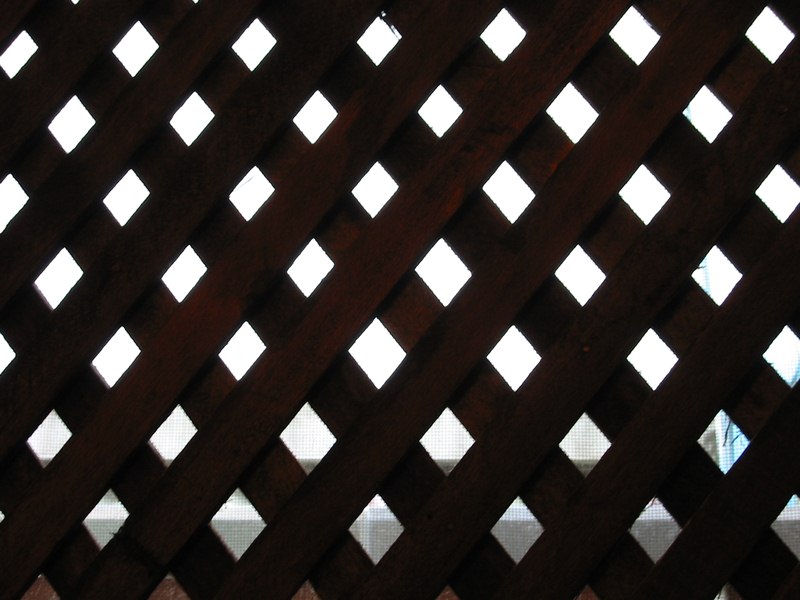Do you need tips on staining lattice as part of an exterior home improvement project? If so, then these ideas for selecting a wood stain and a staining tool can help you to complete the job in an impressive manner.
Staining porch lattice or deck lattice is a process that involves several main steps —choosing your stain, preparing your lattice, and staining your lattice. Should you use a sprayer, roller, or brush? Any of these methods will work —read on and decide which is best for your needs.

Guide to Staining Lattice: What’s the Best Method?
You can stain wooden lattice on a deck or porch in several ways. Possible methods for completing this project include using a sprayer, a paint roller, or a brush to apply stain onto the lattice. Learn more about how to choose the proper type of exterior stain and which staining methods work best.
Must Read:
Freshen Up Lattice With an Attractive Stain
The process of staining lattice in order to make the wood surface look smooth and appealing is not extremely difficult but does require patience and precision. If you are a homeowner who wishes to embark on a do-it-yourself outdoor lattice staining project, then you will need to make decisions in regard to selecting certain materials. Below are more detailed instructions on staining a wooden deck or porch lattice.
Choosing a Stain
The first step in staining your lattice is to select a color and type of stain. The color you choose will likely depend on the wood that your lattice is made of, and the type of stain will depend on your personal preference in regard to long-term upkeep.
A Wooden Porch or Deck Lattice Can Be Stained With:
- Oil-based stain, which is superior in terms of color maintenance.
- Water-based stain, which is best for keeping wood preserved in outdoor conditions.
When Deciding on a Shade or Color Stain, Consider That:
- An opaque/solid stain will completely change the original color of the wooden lattice.
- A semi-transparent stain preserves and protects the natural shade of the wood.
Wood stains are available in a range of light and dark tints. Select a lattice stain that will complement the exterior paint colors of your home.
Using a Sprayer
Many people recommend using a spraying tool to stain lattice because this method is less time-consuming than manual methods of applying the stain. Before using this type of tool, you will need to prepare your lattice for staining and be sure that you have read all the instructions on operating the sprayer.
The basic steps of this process are outlined as follows.
- Clean and sand the lattice prior to using the sprayer.
- Cover all nearby surfaces with a protective sheet or tarp.
- Fill the sprayer with stain and choose the appropriate spray tip (per manufacturer’s instructions).
- Stand one to two feet away from the lattice and spray on the stain with steady horizontal sweeps.
Be sure not to use a sprayer to stain lattice if the weather is breezy or windy because the stain may not adhere properly.
Staining With a Roller Brush or Paint Brush
Other people prefer to stain lattice using either a roller brush or paintbrush. These methods result in less stain product waste than a sprayer produces, but can be messier and hard on the hands. If you choose to stain your exterior lattice with one of these brushes, then these tips are important to keep in mind:
- As is the case when using a sprayer, clean and sand the lattice first.
- If using a roller brush, apply thin layers of stain to the lattice, taking care not to roll too fast and splatter the stain. While the stain is still wet, go over the lattice surface with a brush in order to blend any uneven deposits left by the roller.
- If using a paintbrush, choose one with nylon bristles for water-based stain and natural bristles for oil-based stain. Use smooth brush strokes and apply the stain liberally. To avoid uneven coverage, stain the entire lattice as rapidly as possible.
Whichever method of staining lattice that you choose, remember to allow the stain to fully dry before touching the lattice surface. With a variety of stains available, including environmentally friendly stains, you are sure to find a color and type that will make your wooden lattice look polished and new.
References
- Home Addition Plus; Choosing the Right Deck Finishing Stain – http://www.homeadditionplus.com/dev/decks/choosing-the-right-deck-finishing-stain/
- HGTV; How to Stain a Wooden Deck; http://www.hgtv.com/design/outdoor-design/outdoor-spaces/how-to-stain-a-wooden-deck
Image Credit
- Lattice: https://morguefile.com/p/12072









